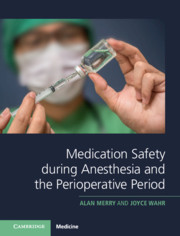Book contents
- Medication Safety during Anesthesia and the Perioperative Period
- Medication Safety during Anesthesia and the Perioperative Period
- Copyright page
- Dedication
- The Snow Vaporizer, Mark II
- Contents
- Foreword
- Acknowledgments
- 1 Introduction to Medication Safety in Anesthesia and the Perioperative Period
- 2 Failures in Medication Safety during Anesthesia and the Perioperative Period
- 3 Failures in Medication Safety in the Intensive Care Unit and Ward
- 4 Impact of Medication Errors on the Patient and Family
- 5 Consequences for the Practitioner
- 6 Why Failures Occur in the Safe Management of Medications
- 7 Errors in the Context of the Perioperative Administration of Medications
- 8 Violations and Medication Safety
- 9 Interventions to Improve Medication Safety
- 10 Medication Safety in Special Contexts
- 11 Legal and Regulatory Responses to Avoidable Adverse Medication Events, Part I: General Principles
- 12 Legal and Regulatory Responses to Avoidable Adverse Medication Events, Part II: Practical Examples
- 13 Barriers to Improving Medication Safety
- 14 Conclusions
- Index
- References
12 - Legal and Regulatory Responses to Avoidable Adverse Medication Events, Part II: Practical Examples
Published online by Cambridge University Press: 09 April 2021
- Medication Safety during Anesthesia and the Perioperative Period
- Medication Safety during Anesthesia and the Perioperative Period
- Copyright page
- Dedication
- The Snow Vaporizer, Mark II
- Contents
- Foreword
- Acknowledgments
- 1 Introduction to Medication Safety in Anesthesia and the Perioperative Period
- 2 Failures in Medication Safety during Anesthesia and the Perioperative Period
- 3 Failures in Medication Safety in the Intensive Care Unit and Ward
- 4 Impact of Medication Errors on the Patient and Family
- 5 Consequences for the Practitioner
- 6 Why Failures Occur in the Safe Management of Medications
- 7 Errors in the Context of the Perioperative Administration of Medications
- 8 Violations and Medication Safety
- 9 Interventions to Improve Medication Safety
- 10 Medication Safety in Special Contexts
- 11 Legal and Regulatory Responses to Avoidable Adverse Medication Events, Part I: General Principles
- 12 Legal and Regulatory Responses to Avoidable Adverse Medication Events, Part II: Practical Examples
- 13 Barriers to Improving Medication Safety
- 14 Conclusions
- Index
- References
Summary
Here we consider various examples of legal and regulatory responses to avoidable adverse medication events. There are a wide range of poorly interlinked regulatory processes, regardless of the country examined. Some approaches are proactive while others are reactive, serving mostly to provide compensation or to punish those felt responsible. Regulation can assist in promoting medication safety through influence and through compulsion, but what is really required is the whole-hearted engagement of everyone in the organization in the mission of achieving safe, high quality patient care. This goal will require both physician efforts, through professionalism and self regulation, and those of hospital boards of directors, through setting priorities and driving a just culture. While there is a role for the civil law (compensation for injured and in some degree of declarative retribution), litigation is likely to most effective when it is directed against institutions. The best approaches are based on “full disclosure and rapid compensation” practices. Criminal action in the regulation of safe medication practices in the perioperative period should be reserved for when recklessness is involved or where deliberate malfeasance is a factor.
Keywords
- Type
- Chapter
- Information
- Medication Safety during Anesthesia and the Perioperative Period , pp. 236 - 264Publisher: Cambridge University PressPrint publication year: 2021

